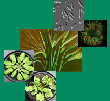| Raffelsbauer, V; Pucha-Cofrep, F; Strobl, S; Knüsting, J; Schorsch, M; Trachte, K; Scheibe, R; Bräuning, A; Windhorst, D; Bendix, J; Silva, B; Beck, E: Trees with anisohydric behavior as main drivers of nocturnal evapotranspiration in a tropical mountain forest., PLOS ONE, 1-21 (2023), doi:10.1371/journal.pone.0282397 | |
| Abstract: This study addresses transpiration in a tropical evergreen mountain forest in the Ecuadorian Andes from the leaf to the stand level, with emphasis on nocturnal plant-water relations. The stand level: Evapotranspiration (ET) measured over 12 months with the Eddy-Covariance (ECov) technique proved as the major share (79%) of water received from precipitation. Irrespective of the humid climate, the vegetation transpired day and night. On average, 15.3% of the total daily ET were due to nocturnal transpiration. Short spells of drought increased daily ET, mainly by enhanced nighttime transpiration. Following leaf transpiration rather than air temperature and atmospheric water vapor deficit, ET showed its maximum already in the morning hours. The tree level: Due to the humid climate, the total water consumption of trees was generally low. Nevertheless, xylem sap flux measurements separated the investigated tree species into a group showing relatively high and another one with low sap flux rates. The leaf level: Transpiration rates of Tapirira guianensis, a member of the high-flux-rate group, were more than twice those of Ocotea aciphylla, a representative of the group showing low sap flux rates. Representatives of the Tapirira group operated at a relatively high leaf water potential but with a considerable diurnal amplitude, while the leaves of the Ocotea group showed low water potential and small diurnal fluctuations. Overall, the Tapirira group performed anisohydrically and the Ocotea group isohydrically. Grouping of the tree species by their water relations complied with the extents of the diurnal stem circumference fluctuations. Nighttime transpiration and hydrological type: In contrast to the isohydrically performing trees of the Ocotea group, the anisohydric trees showed considerable water vapour pressure deficit (VPD)-dependent nocturnal transpiration. Therefore, we conclude that nighttime ET at the forest level is mainly sourced by the tree species with anisohydric performance. |

last modified 2023-04-04

